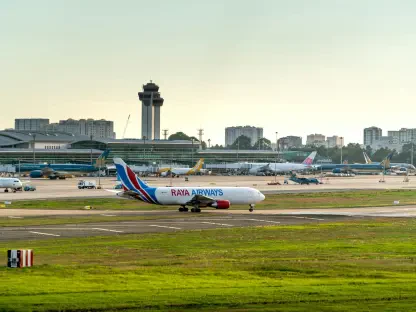The International Air Transport Association (IATA) has released its February 2025 global air passenger demand data, revealing critical trends in the aviation market. While global performance indicators show moderate growth and some regional contractions, Colombia stands out with impressive air travel expansion. This article delves into the data, examining global market trends, regional performance, and the specific factors that differentiate Colombia’s aviation sector from the global landscape.
Global Market Trends
The global aviation market experienced moderate growth across key performance indicators in February 2025. Compared to figures from February of the previous year, Revenue Passenger Kilometers (RPK) grew by 2.6%, while Available Seat Kilometers (ASK) expanded by 2.0%. This growth, although positive, marks a deceleration compared to previous growth metrics, signifying potential challenges and shifting dynamics in the global aviation arena.
The global load factor, a fundamental measure of capacity utilization, showed a marginal improvement of 0.4 percentage points, reaching 81.1%. This increase suggests that airlines are continually striving to optimize capacity deployment amidst uncertain market conditions. By effectively managing capacity and ensuring higher load factors, airlines aim to maintain profitability and sustainability in the face of fluctuating demand.
International vs. Domestic Markets
A significant theme within the IATA data is the contrasting performance between the international and domestic market segments. International markets demonstrated strong growth, with RPK figures increasing by 5.6% compared to the previous year, and capacity expanding by 4.5%. This growth highlights a robust demand for international travel, signaling a recovery and resurgence in cross-border business and leisure activities.
In stark contrast, domestic markets experienced a contraction of 1.9%, along with a 1.7% reduction in capacity compared to the previous year. This divergence points to several potential structural changes in travel patterns. Shifts in consumer behavior, economic factors, and possibly lingering effects of earlier travel restrictions have influenced these contrasting trends. For investors and stakeholders in the aviation industry, understanding these shifts is crucial for making informed decisions about resource allocation and future investments.
North American Market Contraction
The North American market faced significant challenges in February 2025, with a 3.2% decline in RPK. This contraction aligns with recent Federal Reserve data, indicating weakening consumer sentiment due to persistent inflationary pressures. The impact of these economic factors on travel behavior is evident, as consumers and businesses alike exercise caution in their expenditure.
Furthermore, this trend may predict subdued retail performance in the upcoming quarters, potentially exacerbated by increased U.S. tariffs affecting inbound and outbound tourism. Airlines relying heavily on the North American domestic market may face financial headwinds, requiring strategic adjustments to navigate this challenging economic landscape. The pressure from inflation and trade policies highlights the need for flexibility and innovation in maintaining competitiveness.
Continued Growth in Latin America
In contrast to the North American market, Latin America displayed remarkable resilience, with a 4.6% growth in RPK. This significant increase suggests strong travel demand and reflects consumer confidence in the region, highlighting economic resilience amid broader challenges. Despite regional economic uncertainties, the Latin American market has demonstrated robust performance that stands out on the global stage.
Of particular interest was the 8.0% expansion in Brazil’s domestic market, which points towards vigorous intra-regional business activities. This growth presents favorable prospects for Colombian export sectors, as enhanced intra-regional trade can lead to increased economic opportunities and strengthened business connections within the region. For Colombia, the Latin American market’s growth represents a promising opportunity to capitalize on regional economic interconnectivity.
Asia-Pacific Market Performance
The Asia-Pacific region reported a 4.2% growth in RPK, which underperformed historical averages. This slower momentum may influence economic growth projections for the region, potentially affecting global supply chains and demands for commodities. The region remains a critical hub for global air travel; thus, any fluctuation in its performance can have far-reaching implications.
Despite the slower-than-expected growth, Asia-Pacific continues to be a significant contributor to global aviation. The region’s economic activities and travel demand play a crucial role in shaping the global aviation landscape. Therefore, stakeholders in the aviation industry must closely monitor the Asia-Pacific market’s performance and adjust strategies accordingly.
European Market Persistence
Despite facing economic headwinds, the European market displayed a 4.3% growth in RPK, underscoring the resilience of travel demand within the region. Both tourism and business travel activities have sustained momentum, contributing to the overall robustness of the European aviation sector. This persistence highlights the region’s ability to adapt and thrive in the face of economic challenges.
An interesting dynamic to consider is the potential decline in North American tourism, which might benefit Europe under current tariff scenarios. As travel demand shifts, Europe could attract more travelers, leveraging its appeal as a destination for both leisure and business purposes. This shift would have broader implications for the European economy and its financial outlook, presenting new opportunities for growth and investment in the aviation sector.
Implications for Yield and Profits
The observed divergence between the 2.6% growth in RPK and the 2.0% expansion in ASK suggests potential yield improvements, a critical factor for airline profitability. In capacity-constrained environments, airlines with dominant market positions may find themselves with significant pricing power, enabling them to capitalize on increased demand and optimize revenue streams.
For investors, this scenario presents opportunities to focus on airlines with a strong international presence. Such carriers are likely to offer more promising growth potential compared to those primarily focused on domestic markets facing challenges. By strategically investing in airlines positioned to leverage international demand, stakeholders can maximize returns and navigate the evolving aviation landscape effectively.
Colombia’s Strong Performance
Colombia has demonstrated robust air travel expansion amidst the global market slowdown. The 6.7% rise in Latin American international traffic underscores strengthened business connectivity within the region. High load factors among Latin American carriers further indicate effective capacity management, positioning Colombian airlines favorably for future growth.
Colombian carriers engaged in international operations are expected to experience sustained strong performance, benefiting from regional economic dynamics and increasing demand for international travel. This positive trend boosts confidence and investment in the local aviation sector, highlighting Colombia’s potential as a key player in the global aviation market.
Investment Implications
For institutional investors and financial professionals, the data from February 2025 provides invaluable insights. Airline equities, particularly those with extensive international exposure, present compelling investment opportunities. Conversely, carriers heavily reliant on the North American domestic market may warrant a more cautious approach due to market-specific challenges.
Airport operators managing international hubs are likely to outperform those focusing predominantly on domestic markets. Additionally, aircraft lessors can anticipate stable demand for wide-body aircraft, given the consistent ASK growth for international routes. Sustained international travel could also bolster the currencies of tourism-driven economies, offering further investment considerations.
Financial professionals should integrate these aviation metrics into broader economic analyses to enhance forecasting accuracy and make informed strategic decisions. By considering the nuanced performance of different markets, stakeholders can better navigate the complexities of the global aviation landscape.
Economic Indicator Correlation
The differing trajectories of international and domestic air travel correlate with broader economic indicators. Notably, international business travel often precedes capital investment by several months, serving as a key predictor for future economic activity. Domestic leisure travel, on the other hand, aligns closely with consumer discretionary spending patterns, reflecting the overall health of household finances.
Furthermore, air cargo demand, though not covered in the present data, typically acts as an indicator for future trade volumes. By understanding the interplay between these variables, financial professionals can gain deeper insights into economic trends and make more precise predictions. Integrating aviation data into economic analyses enables more comprehensive and nuanced forecasting.
Forward Outlook
While February 2025 marked record volume levels, the observed slowdown in growth rates and weak performance in key markets like North America might signal the beginning of a broader slowdown in the global transportation sector. This aligns with projections for moderated economic activity towards the latter part of the year, emphasizing the role of aviation metrics as reliable leading indicators.
For financial institutions holding travel-related debt instruments, heightened credit monitoring could be prudent, especially for airlines with high operating leverage and substantial exposure to underperforming regions. By proactively managing risk and staying attuned to evolving market conditions, stakeholders can navigate potential challenges and capitalize on emerging opportunities.
Strategic Considerations
The International Air Transport Association (IATA) has published its February 2025 global air passenger demand data, highlighting key trends in the aviation industry. The data shows that while the overall global performance exhibits moderate growth, there are regional disparities with some areas experiencing contractions. Notably, Colombia emerges as a significant player with remarkable expansion in air travel. This insight delves into the data, analyzing global market trends, regional performance, and the unique factors that set Colombia’s aviation sector apart from the global scene. By examining these aspects, one can understand the driving forces behind Colombia’s robust growth in air travel compared to other regions. The article underscores the importance of these trends and the potential implications for the aviation market as a whole. Thus, it provides a comprehensive overview of the current state of global air travel with a special focus on Colombia’s exceptional progress.









